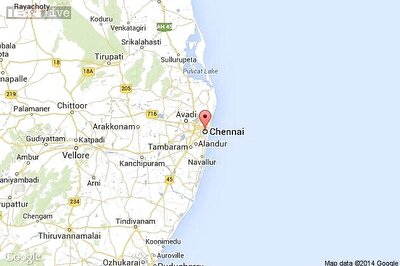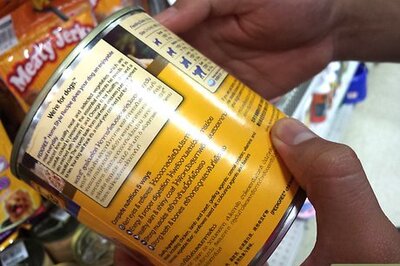
views
Cleaning a Wooden Cutting Board
Scrape off any food particles before you wash the cutting board. Use a spatula, bench scraper, or dull knife to gently scrape away any food on the surface of the cutting board. Because it’s best to minimize how much water you use on your cutting board, it can be helpful to dry clean stuck-on particles before you start washing. Don’t gouge your scraper into the wood—if anything is stubbornly stuck to the cutting board, you can remove it during the washing process.
Scrub the cutting board with soapy water. Chiu recommends using a “stiff brush or sponge with dish soap and warm water” to clean your wooden cutting board. Sears agrees, and adds that you should “be sure to scrub any food spots away.” Don’t submerge the cutting board in a sink full of water as you’re cleaning—only use as much water as you need.
Break down stubborn food with peroxide or lemon juice. If you’ve scraped and scrubbed your board and there are food particles you just can’t remove, cover the food with 3% hydrogen peroxide, baking soda, vinegar, or lemon juice. Let it sit on the stain for about 5 minutes, then continue cleaning. You can also use these to remove food stains from the board.
Rinse the entire cutting board with clean water. Be sure to get water on every side of the wood—top, bottom, and side edges. If only one side gets wet, the wood will swell unevenly, which can lead to warping and cracking. Don’t soak the cutting board in water. Instead, pour the clean water over the board until it’s fully rinsed.
Rub the cutting board with salt and lemon for a deep clean. Sprinkle salt over the top of the cutting board, then scrub the salt into the board with the cut side of a lemon half. If there are any stains on the cutting board, squeeze a little extra lemon juice on the area and let it sit while you finish cleaning the rest of the board. When you’re finished, rinse the board well. Chiu agrees that scrubbing the board with salt will help you get food particles out of the “smaller crevices and cracks in the board, but he prefers to skip the lemon and just “rub the salt into the board with a towel.” You probably won’t need to do this every time you clean the cutting board, but it’s a good idea if you start to notice discoloration or odors on your board.
Pat any moisture off the board, then prop it up to air dry. When you’re finished cleaning the board, gently pat away any moisture with a clean, dry cloth or paper towels. Then, sit the cutting board upright on its side, leaned against a wall or the side of your sink. That way, air will circulate around the board so it can dry completely. If the cutting board dries unevenly, the wood can warp and crack. If you’re going to sanitize the cutting board, you can wait to dry it until you’re finished with that.
Sanitizing and Deodorizing a Wooden Cutting Board
Sanitize the board anytime you use it for meat, fish, or produce. You probably know that you need to sanitize any surface that comes into contact with raw meat, poultry, fish, or seafood, but you might be surprised to learn that you need to sanitize surfaces after you cut fruits and vegetables, too. Raw produce can carry germs like Salmonella, Listeria, and E. coli, all of which can make you sick. Wash your fruits and vegetables before you cut them. This will typically make them safe to eat, but for extra safety, you should still sanitize your cutting board afterward.
Wipe down the board with diluted bleach to disinfect it. Add 1 US tbsp (15 ml) of unscented chlorine bleach to 1 US gal (3.8 l) of water. Generously pour the bleach mixture over every surface of the cutting board. If you prefer to avoid bleach, sanitize the board with undiluted white vinegar followed by 3% hydrogen peroxide. You can also use a commercial food-safe sanitizer, if you prefer.
Deodorize your cutting board with hydrogen peroxide, vinegar, or lemon juice. If your wooden cutting board starts to develop a musty odor, Chiu recommends wiping it down with a cloth dampened with hydrogen peroxide. You can also use lemon juice, or white vinegar. This will help kill any bacteria that’s causing odors in the wood.
Dry the cutting board completely after you sanitize it. Use a clean towel or paper towels to pat the excess moisture off of the wood. Then, prop the cutting board up so it can air dry. Don’t let any moisture sit on the board—this can allow bacteria to return, so your board won’t be sanitized.
Caring for a Wooden Cutting Board
Avoid soaking the cutting board in water. Never put a wooden cutting board in the dishwasher or soak it in the sink. Wood is absorbent, and according to Sears, leaving it soaking for too long “can result in mold or bacteria growing inside the board.” Try to quickly wipe down the board if you cut anything on it that holds a lot of moisture, like fruit. Additionally, avoid using your cutting board when it’s wet. The wood will be softer, which means it will be easier to leave knife marks in the board.
Oil your board when the wood becomes absorbent. Pour a thin layer of food-grade mineral oil onto the cutting board, then rub it into the top, bottom, and sides with a paper towel. Let that soak into the wood for a few minutes, then repeat the process until the oil doesn’t seem to be sinking into the wood anymore. Wipe away any excess and let the board dry overnight. According to Miller, you can add a little salt to the board when you’re oiling it to improve the seasoning. Sprinkle a few drops of water on the cutting board. If they spread out and start to sink into the wood, the board needs to be oiled. Oil the cutting board as soon as you get it unless it comes pre-oiled. After that, you’ll usually need to oil your cutting board about once a month—but it depends on how often you use it.
Use board cream or beeswax after you oil the cutting board. After you’ve let the oil soak into the wood, rub board cream or 100% beeswax over every side of the cutting board. Let that soak into the wood overnight, then use a paper towel or clean cloth to wipe away any excess the next day. You can purchase pre-made board cream or make your own. To make your own board cream, mix ⁄2 tsp (2.5 mL) of beeswax with 1 cup (240 mL) of food-grade mineral oil. Microwave the mixture for 30–45 seconds. It will be easiest to spread over the board if you use it while it’s warm.
Sand the board occasionally to resurface it. You may be able to remove knife marks by sanding the wood. Start by cleaning and sanitizing the board, then buff out any scratches with 220- or 400-grit sandpaper. When you’re finished, wipe the board clean with a damp cloth or sponge, then allow it to air dry. Oil the wood after you sand it to restore the seasoning.
Replace your cutting board if it gets deep knife marks. Over time, your knives may leave behind scratches or grooves in the wood. These can harbor bacteria that can be difficult to remove, even if you wash or sanitize the board. To be safe, toss out the board or use it for cracks once it develops deep scratches that you can’t sand out. If the wood warps and cracks, you should also replace it for the same reason.




















Comments
0 comment